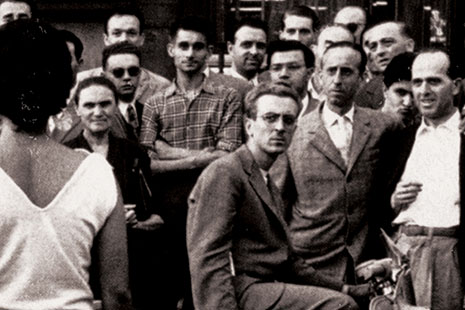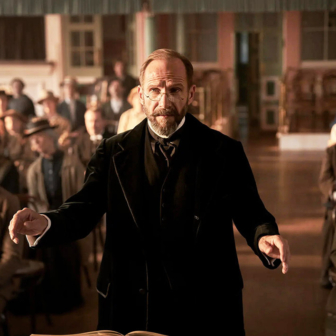Death and the Dolce Vita: The Dark Side of Rome in the 1950s
By Stephen Gundle | Canongate | $25.95
LUCHINO Visconti’s masterpiece Senso (which has recently been released by Criterion in magnificent DVD and Blu-ray editions) belongs to that period in the history of Italian cinema, the early 1950s, when the forthright gaze of neorealism was giving way to glossier and more glamorised, if not necessarily rosier, views of the world. Senso began shooting in 1953 and was given its first theatrical showing late in 1954. It was not especially well received at the time. With its period setting, lush art direction and operatic plot, it seemed to many to be a betrayal of Visconti’s earlier commitment to the quasi-documentary, neorealist style, a rejection of real life in favour of melodrama. Visconti was unrepentant. “I like melodrama,” he later said in an interview, “because it is situated just at the meeting point between life and theatre.” And it is at that very meeting point that the film begins, in a scene set during a performance of Il Trovatore. Alida Valli, playing the countess who is shortly to fall for Farley Granger’s handsome cad, is asked whether she likes opera. “Of course,” she replies, “I like it very much.” But, she immediately adds, “I don’t care for it offstage.”
Valli was already a well-established actress. She had appeared in more than forty films, and was known internationally for her roles in, for example, Hitchcock’s The Paradine Case (1947) and Carol Reed’s The Third Man (1949). Yet in the same year Senso was being filmed, with Valli – as the obsessive and self-destructive countess – delivering to the cameras what many now regard as her greatest performance, a real-life melodrama was developing that would come close to ending her career. It became known as the Montesi affair, and its repercussions continued for years. It is, says Stephen Gundle in his absorbing study of the case, Death and the Dolce Vita, a “very Roman story” of the intersection between glamour (a subject on which Gundle has already published widely) and the harsh facts of life, between old and new ways of looking at the world.
Gundle’s account begins in April 1953 with the disappearance of twenty-one-year-old Wilma Montesi from the home she shares with her parents, grandparents, sister and brother. After failing to return from an outing at the expected time, she is reported missing, and a day and a half later her body, partly undressed, is found washed up on a beach. What happened during those thirty-six hours was and remains a mystery. The strong likelihood is that she was murdered, or accidentally killed by a companion or companions and her body dumped, but nothing is quite certain. It could have been a simple case of misadventure. Wilma’s family thought so, a belief they stuck to through a succession of investigations, reports and trials. By their account, Wilma had complained of sore and blistered heels caused by the rubbing of her new shoes, and had heard that bathing her feet in seawater would provide relief. She had taken herself to the coast and, “perhaps due to her period, had fainted, slipped into the water and drowned.”
In one of the many instances of overlap between reality and the world of cinema, Gundle records how the actress Anita Ekberg, having scratched her heel while dancing one summer evening in 1958, was photographed later that night bathing her feet in the Trevi fountain. The picture went round the world, helping to inspire Fellini to conceive La Dolce Vita, to cast Ekberg, and to include in the film the famous scene in which she bathes in the Trevi fountain. Life and cinema were coming together. The photograph also ensured that Ekberg’s late-night paddle became, “after Wilma Montesi’s… the most famous foot-bathing incident in 1950s Rome.”
In Wilma’s case, Gundle suggests, the “foot-bathing theory” provided her family with a way of preserving her dignity and reputation after death. Five years later, when the case was still very much in the public mind and speculation continued unabated, the photograph of Anita Ekberg seemed to bring out all the underlying eroticism of the earlier story. By that time, the “new flashbulb version of reality” was making it increasingly difficult to preserve older notions of privacy and modesty. It was also making it harder to keep secrets.
Like many Italian women of her age, speculates Gundle, Wilma was captivated by the cinema, and the possibility it held out of being “discovered” and thereby transported to a glamorous and interesting life. Thanks to the widespread practice of dubbing, film acting in 1950s Italy meant that even speaking parts didn’t necessarily involve speaking, suggesting to the star-struck that the chances of being talent-spotted – in reality remote – were really just a question of having the right look, of being in the right place at the right time, preferably in the company of the right people. But the right people have a way of turning out to be the wrong people, and Gundle leads us deftly through a complex web of interconnections between those – politicians, bureaucrats, journalists, artists, actors – whose motives are obscure and whose knowledge of the circumstances surrounding the death of Wilma Montesi can never be convincingly pinned down.
Referring to one of the many supporting players in this offstage drama, Gundle comments that “her precise role was unclear.” This “mysterious woman” may have been a government agent, he observes drolly, but on the other hand she may not. She is not alone in being hard to pin down. No one’s role is clearly defined, even those who are at one time or another most directly accused of complicity in Wilma’s death. Most prominent among these were Ugo Montagna – a wheeler-dealer and one of the so-called Ciampino nobles “who secured their titles more or less as the plane taking the royal family into exile was rolling down the tarmac” – and Piero Piccioni, the son of a prominent politician. A talented jazz musician and composer, Piccioni survived the scandal and went on to a highly successful career in which he was responsible for hundreds of film scores and soundtracks.
But for a while there, things looked grim for Piccioni. The evidence against him may have been largely circumstantial and founded in rumour and the speculations of the press, but he was detained and arrested, investigated and re-investigated, before ultimately appearing as one of the defendants in the “Venice trial” of 1957. All of them, including Piccioni, were acquitted. Crucial in Piccioni’s defence was the testimony of his lover Alida Valli, who backed his version of events, confirmed his alibi, and never wavered in the essentials of her story, even as she became progressively less enamoured of the man himself. The experience, played out in public, badly affected Valli’s confidence and her capacity to continue in her career. By the time of the trial “she had been out of work for two years.” Valli did later recover some of her earlier momentum, but not before she had learned, like the countess in Senso, what can happen when real life – in this case the real life and real death of Wilma Montesi – is turned inexorably into melodrama. •




